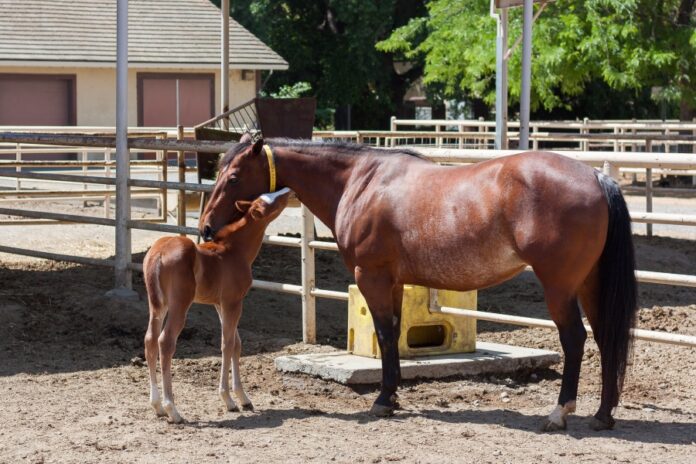Spring brings new babies to animal facilities on campus
Foals, calves, piglets, lambs, kids, chicks — there’s nothing cuter than baby farm animals. Young animals like these are taking their first breaths on campus at various animal facilities this Spring Quarter.
Breeding occurs at all of the animal facilities on campus, which include goats, horses, swine, dairy cattle, beef cattle, sheep, laboratory animals and avian species.
Breeding seasons vary depending on the animal, according to animal facilities coordinator Dan Sehnert. Some, such as swine, give birth year round, but goats, sheep and horses are seasonal. Beef cattle are “calved” in either the fall or spring.
“Springtime is usually sheep and horses,” Sehnert said. “Right now, we just finished up with sheep. I think we have just a handful of goats left to kid out. We still have some horses left to foal.”
UC Davis has breeding programs because they need animals for teaching in the animal science department, doing animal agriculture outreach, holding clinics for members in the industry and completing animal agriculture research, according to Sehnert.
Students who want to become involved in the breeding process can take part in internships at the animal facilities or take animal science classes. Students can take classes in the ANS 049 series, where each class learns about a different animal at one of the various facilities, according to Sehnert.
“The class is very hands on and is a good way to expose yourself to a lot of animal facilities and animal agriculture,” Sehnert said.
At the horse barn, students can take part in a foal-management internship that lasts six months over Winter and Spring Quarter. Students put in 20 hours each week working with the foals born in the previous year. At the end of the internship in June, students put on a foal auction where the foals are sold to the public.
According to first-year animal science major Caroline Ong, who had an internship at the goat facility Winter Quarter and has an internship at the horse barn this quarter, the foals are big, playful and very enjoyable to work with.
“They’re born with the same length of legs that they are going to be,” Ong said. “They’re playful, but they don’t realize how big they are I think so they’ll get in your face. They’re really mouthy because they’re still in that stage where they are nursing so they want to bite everything.”
Before the kids are born at the goat facility, students help check their tattoos, trim their hooves, clean their pens and take inventory, according to Ong. Once the goats start “kidding,” as the goats give birth, students catch the kids in buckets, mark which dam the kid came from, cut the umbilical cord and give each kid an ID number. Then students take care of the kids by feeding the babies and marking how much each one eats.
“Feeding the baby goats was the best part,” Ong said.
At the beef facility, students help artificially inseminate the cattle to breed them. Once the calves are born, students help with cattle checks, where they see which cows have given birth or are almost ready to give birth. Students tag the calves of cows that have “calved,” give the calves vaccinations and take their birth weight, according to first-year animal science major Shelby Dunfee, who lived at the beef unit last year and has an internship at the Sierra Field Station this year.
“[Calving] is such a neat thing and a special part of life we get to see happen,” Dunfee said. “That has really made me appreciative [of] this whole industry in general. I love to see brand new calves stand up for the very first time, or see when [their] mom and them finally bond and that’s just a part of mother nature that is really neat to see.”
According to Dunfee, breeding is a long process that requires a lot of hard work and effort to keep the cows healthy. The process begins in January with ensuring the breeding cows are fed enough to keep them in the best condition.
“It’s a lot of work on them to calve and so we really take pride in making sure our animals are in top shape here and that a lot of work goes into the whole process,” Dunfee said.
According to fourth-year animal science major Allie Carmickle, who has worked at the beef facility for two years, for beef cattle, most of the bull calves are kept and turned into steers, which are neutered males, and eventually sent to slaughter. Females are kept as replacements of older cows to breed or are sold.
Carmickle said she loved the opportunity to see the progress of the long breeding process, from breeding then nine months later to the calf being born, to the adult cow growing up two years later and then finally to the meat product in the end.
Depending on the type of animal, the young animals end up in different places. According to Sehnert, swine and lambs are used for teaching, research or end up in the animal science meat science laboratory.
For students interested in learning more about the baby animals without taking a class, Sehnert said anyone can visit the animal facilities. Students can go talk to the facility managers or students who live at each facility and receive information about the animals, get tours of the facility or see the babies.
“[Students] are more than welcome to stop in at those animal facilities and visit if they just want to see baby animals,” Sehnert said.
Written by: MARGO ROSENBAUM — features@theaggie.org



